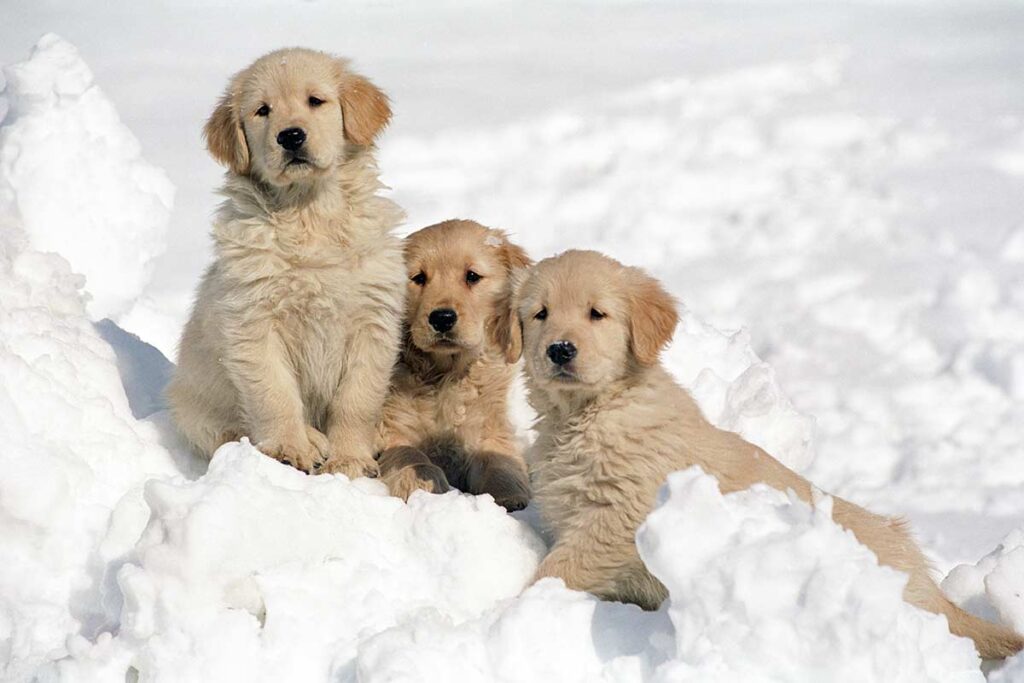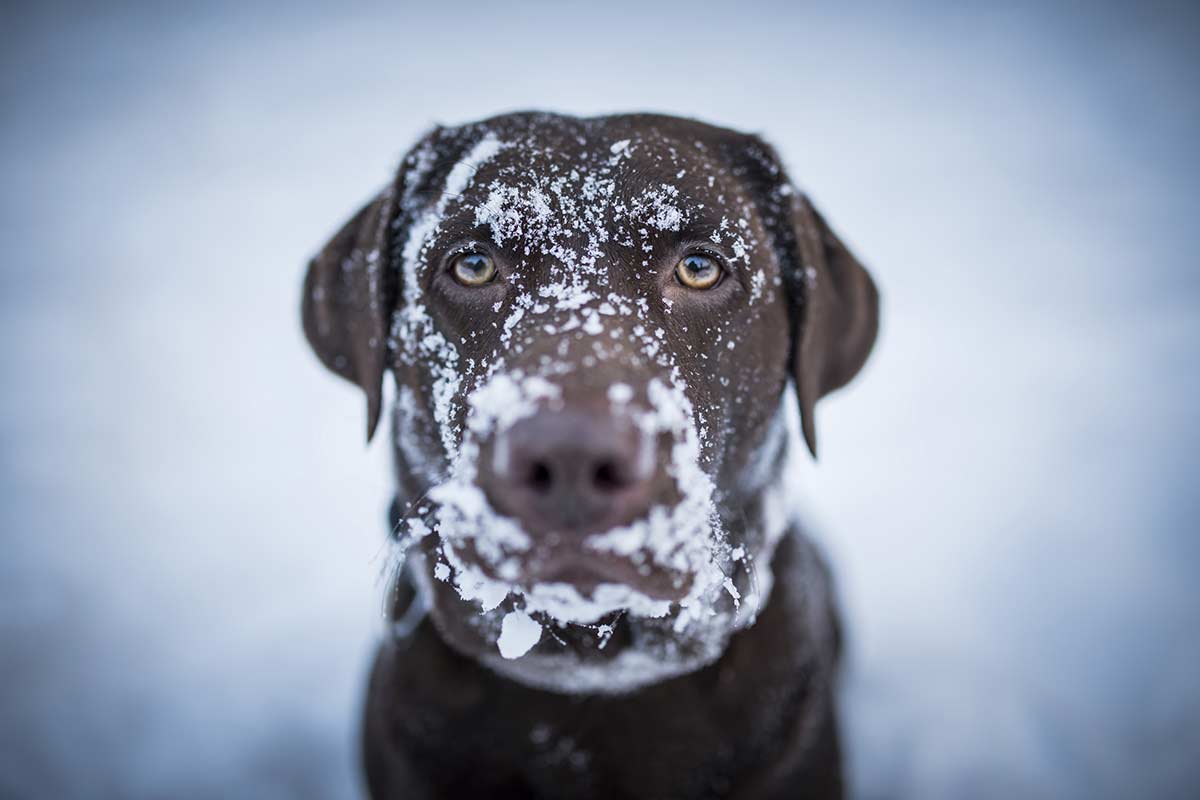Big and beautiful are the best words to describe a Labrador. This breed is known to grow up to 24 inches (61 cm) tall with an average weight of about 70 pounds (32 kg). During the summer, it is easy to keep them outdoors during the day or night, but how do you handle your Labrador during the winter?
A Labrador can stay in the cold for a few hours to the whole day, and sometimes overnight. It depends on their age, weight, health, temperature, and wind speed. However, if things get extreme, it is advisable to keep your pet inside.
In this article, I’ll offer insights on how to handle your Labrador during winter to ensure that they are comfortable, accessible, and safe. I’ll also provide insight into how to keep your dog warm and when to bring them inside.
Table of Contents
Do Labradors Handle the Cold Well?
Labradors can handle cold weather quite well. This breed is known for its thick double coat, which allows them to remain warm even when temperatures drop. They can regulate their body temperature in temperatures as low as 35F° (1.67C°).
As a breed, Labradors are adept at handling low temperatures and have evolved to deal with this change in season. They are, however, not Alaskan malamutes. Even though they can take the cold, they are not designed to handle freezing temperatures.
Thus, they can comfortably survive in the cold for limited periods and under specific temperature ranges. Beyond a certain point, bringing them indoors or putting them in their kennels is advisable.
This adaptation comes from the fact that Labradors were bred in Newfoundland, Canada, where winter temperatures average around 32°F (0°C). They were originally used in fishing, which means they had to do a lot of work in the water.
This is where their thick double coat comes in. It is water-repellent, which allowed them to move in the water with agility and dry off more easily after they got out of the water. But it also helps keep the cold at bay when the temperatures drop, acting as an extra effective insulation layer.
This is also the reason why Labradors shed so much hair. They shed each coat at different moments of the year.

How Cold Is Too Cold for a Labrador?
Temperatures below 20F° or -6.7C° can easily harm your Labrador. Keeping your Labrador outside for extended periods at such temperatures puts it at risk of frostbite and hypothermia.
Since Labradors are not accustomed to survival in subzero temperatures like sled-pulling dogs, low temperatures will eventually harm them. Keep a keen eye on the weather during the cold months to ensure that your Labrador is not at risk from the elements.
How to Know if It’s Safe To Leave Your Labrador Outside for the Night
To tell if it’s safe for your dog to stay outside overnight during the cold weather, it is advisable to consider their age, weight, health, wind, cloud cover, dampness, and level of conditioning.
Age of the Dog
The age of your Lab will determine if it can be left outside at night in the cold weather. Though this breed of dog enjoys being in the cold weather from time to time, Labs that are too young or too old should not be left in the cold for prolonged periods.
In their early or late ages, dogs cannot properly regulate their internal body temperature. At this point, their bodies are weaker, and their organs are not functioning at optimum capacity.
Labs below ten months and above eight years of age should not be kept in the cold for long periods, especially overnight. The risk of them getting frostbite or even dying is relatively high at this age.
Weight of the Dog
Insulation is vital in surviving cold weather, especially for pets, since they rely on their body’s temperature control mechanisms to survive. This is why your Lab’s weight is a high consideration to determine if it can be left outside.
A healthy weight means the dog has enough body fat to offer insulation in the cold. It will also make the dog more comfortable when it stays outside for a long time. A labrador with a weight greater than 55 pounds (25 kg) should be able to comfortably survive a night out as long as the other factors remain constant.
The Health of the Dog
If the age and weight of your Labrador are okay, then consider its health. It is ill-advised to leave sickly dogs outside when the temperatures drop. This is because if a dog is sickly already, its immunity is compromised and its body is weak, putting it at a high risk of contracting other illnesses. It is best to only consider leaving healthy dogs outside, as this will strain their bodies less.
Cloud Cover
One of the environmental factors to consider is the level of cloud cover. This helps you assess how the temperatures will progress as the night wears on. A cloudy night is a better option since the temperatures will be manageable, and the clouds will help keep more of the sun’s heat trapped in the atmosphere.
A clear night gets colder with time as the heat from the sun slowly dissipates, and temperatures tend to drop further as it progresses. You should check your area’s weather report and take a look at the cloud cover from time to time.
Level of Dampness
Damp objects lose heat faster as the temperatures drop. If your dog is wet from swimming or playing in the water, it is best to ensure they spend the night indoors. Leaving a damp Lab outside for a long time during the cold weather puts it at a high risk of hyperthermia and frostbite.
If you intend to leave your dog outside, ensure it does not play in the water during the day. Avoid washing your Labrador in the evening if you want to leave it outside overnight during the cold season.
Conditioning of the Dog
How you condition your dog will determine if it is okay to sleep outside when it’s cold. Though they have a double coat, not all Labradors can sleep outside on their first try. It is good to occasionally leave it out in the cold to ensure it builds tolerance. Once your Lab can stay outdoors for extended periods in cold weather, you may be able to let it sleep outside in the cold.
The Wind
It is colder on a windy night than on a calm one, which is why you should consider the windiness even when the temperature is higher than recommended. The wind carries away the warm air and delivers colder air, which can drastically drop the temperatures.
Before you leave your Lab outside overnight, make sure that it is a calm night with low chances of it getting windy. This will ensure that it stays in an environment with less temperature fluctuation.

When Should I Bring My Labrador Inside?
There are times when you need to bring your Lab inside or put it in its kernel. These are once the temperature gets too low, about 10F° (-12C°), when it starts to rain or snow, when there is thunder, or if your dog’s coat is too short.
Leaving your Labrador outside needs a level of oversight to ensure that they stay safe during this period. Sometimes it is best to bring the dog indoors or confine it to their kennel even after you have decided to let them sleep outside during the cold weather.
These are the occasions where you should call it quits and bring your labrador inside:
It Gets Windy
If the night suddenly gets windy or the wind speeds climb to high levels of about 50 miles per hour (80 kph), then it’s time to bring your dog inside immediately. The chances of temperatures rapidly dropping on a windy night are high, which puts your Lab at risk of frostbite and hypothermia.
There are also times when your Labrador will whimper on a windy night out of fear or cold. Windy nights also put your pet at risk of getting hit by debris or garbage carried as the wind picks up speed. It is best to bring them inside in such situations.
It Starts To Snow or Rain
The weather can be unpredictable at times, and it may start to rain or snow out of nowhere. At such times, bring your dog indoors to keep it safe from the elements. The double coat can’t protect your Lab from the adverse effects of spending the night in the snow or rain.
Prolonged exposure to rain or snow could also leave your dog suffering from pneumonia. It is your responsibility to bring them in, dry them off, and set them up in a warm, comfortable place to spend the night.
The Temperatures Drops
A drastic change in temperature to 10F° (-12C°) or lower puts your dog at risk. They could even freeze to death. Monitor the temperature from time to time if your dog is sleeping outside in the cold season. This will allow you to respond quickly to a temperature change before it harms your dog.
There’s Thunder and They’re Scared
Children, dogs, and even some adults get easily scared by the sound of thunder.
The loud noise that comes with it and the flashing lights are uncomfortable for many dogs, and it drives them to seek safety elsewhere. It is thus best to bring your Lab inside if thunder repeatedly strikes at night, especially if it scares them. This will ensure that it is safe at home and doesn’t run away in search of safety.
Their Coat Is Short
If you cut your dog’s coat for one reason or another, they should not be allowed to spend the night outside. A healthy full-grown coat is necessary for the dog to regulate its temperature, especially on a cold night. If your dog has a short coat, keep it inside until the fur grows to a good height, as it can keep itself warm without additional help.
How to I Know if Your Labrador Has Frostbite or Hypothermia
If your Labrador is pale, feels numb, has very cold ears, and its muscles and joints are stiff after spending the night outside, these are signs your dog is suffering from frostbite and hypothermia, which will require a trip to the vet.
If your dog’s body gets extremely cold, it will have difficulty circulating heat to its extremities. This means that the ears, paws, and tail will get less heat than the core body. At times like these, ice crystals tend to form on these parts that are not receiving enough heat, damaging them as time goes by.
Signs of Hypothermia
A dog suffering from hypothermia will exhibit the following signs.
- Shivering
- Lethargy
- Muscle stiffness
- Difficulty walking
- Cool body surfaces
- Pale gums
- Confusion
Signs of Frostbite
A dog suffering from frostbite will exhibit the following signs.
- Numbness
- Paleness of the skin
- Lathergy as joints and muscles gradually stop working
- Loss of sensation is in some areas and discomfort in others
- In the extreme, the dog may become catatonic and eventually die
After a night out, it is advisable always to inspect your dog for signs of hypothermia or frostbite and address the situation as soon as possible to prevent permanent damage to the body of your Labrador.
Conclusion
Labradors can stay outside for long periods if temperatures do not drop below 20F° (-6.7C°). However, you shouldn’t treat them as if they were arctic dogs.
As the owner, you are responsible for caring for your Lab during the cold weather. It also falls on you to monitor your dog’s temperature and health if you leave it outside during the cold season. If you are not confident that it is safe for your dog to be out or how long it can stay in the cold, then keep it indoors or consult your vet for guidance.



